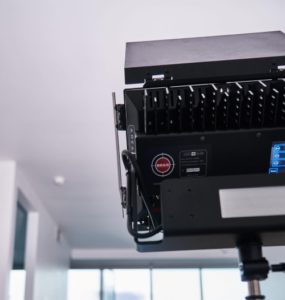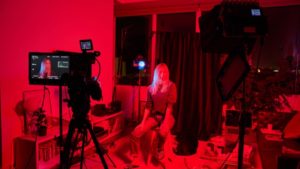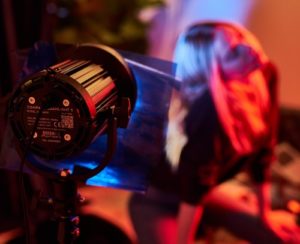
Undaunted by the advent of the COVID-19 pandemic, Directors Michael Livingston and Amanda Dreschler decided to make a short film with Cinematographer Dan Kneece, using the resources available to them and turning to BB&S Lighting to help create the right mood for the film. Thus was born We Can’t Go On, a 19-minute short shot on their own Hollywood rooftop that mirrored the emotional and physical experiences they were going through, and putting themselves into many of the roles normally done by others, including acting and editing.
Knowing that they would have to make this short film with minimal crew, they called upon DP Kneese, who made his bones as a Steadicam operator, as well as calling upon Michael Valinsky to exec. produce. Canon‘s Michael Bravin provided them with the new Canon C300 MkII and Sumire primes for the shoot and Kneese turned to the BB&S Area 48 Color as his lighting choice, having used it on an unreleased indie film previously.
Livingston confirms that the Area 48 was their main light for the shoot, “We used it in almost every scene. Even in those that were primarily natural daylight, we almost always had the Area 48 bouncing for some extra fill. We shot against bright windows in full daylight for the workout scene at the beginning of the film. The Area 48 gave enough power to bring up the exposure in the apartment close to the exterior so we didn’t blow out our windows.”

Kneece concurred, “The colors on the Area 48 were stunning and essential in getting the neon look of the film. We would never have been able to achieve the bright colored sequences with gels. In our lava lamp scene we were able to tune the colors to an almost exact match with our lava lamp and dim it down to look as if the lamp cast a glow on our faces. Without the Area 48 we wouldn’t have been able to fine-tune that scene the way we did. The power, versatility and flexibility of this light is incredible. It has the adjustability to match almost any other colored source.”
Kneece ended up helping the couple with lighting and shooting remotely while being across town in Marina Del Rey, as Livingston worked the camera. “The waveform was a saving grace as we bounced the signal over two laptops so we could collaborate,” Kneece explains. “By pointing Michael’s laptop at the production monitor, working on this film didn’t seem much different that other films when you’re working from video village on a normal set. The process actually worked really well.”

The Area 48 Color helped with a lot of the more difficult aspects of the shoot, such as capturing Dreschler’s “gossamer complexion” in the many close-ups required. “We’re always experimenting with different make up, different lighting,” said Michael. “This time around we found it very easy to get good beauty shots with the Area 48. The quality of light that comes from it is so soft, especially with the soft box, it gave a very luminescent quality to our close ups. With Dan’s help we lit the scene the way it needed to look, and the light just bounced beautifully off her skin—it did all the work for us.”
It also explained with what was a more difficult sequence involving a lava lamp. “Lava lamps by nature are not the most precise light sources so thank goodness the Area 48 Color is,” Kneece said. “We were able to match the lava lamp perfectly and use the Rotolight to make up the difference with a bit of gel. The trickiest part was positioning the camera, lights and actors so they were attractively lit and photographed without shadowing them from the fixture or getting unwanted light on the lava lamp or their faces. It was a very precise shot to make work.”
Livingston also thought that the Area 48 worked well with Canon’s Sumire lens, but they aslso turned to the Force-7 for harder LED lights needed for their filming limitations, as well as the CBL-1 Compact Beamlight. Kneece was generally happy with how the film ended up looking considering that it was shot in the filmmaker’s apartment without blowing a breaker.
You can watch We Can’t Go On, written, directed and starring Dreschler and Livingston below:





